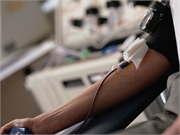Less than half of blood donors with low ferritin at index achieved adequate stores within 12 months
FRIDAY, June 5, 2020 (HealthDay News) — Most, but not all, teenagers have adequate iron stores within 12 months after whole blood (WB) or double red blood cell (2RBC) donation, according to a study published online June 5 in Pediatrics.
Ralph R. Vassallo, M.D., from Corporate Medical Affairs, Vitalant, in Scottsdale, Arizona, and colleagues measured serum ferritin in 30,806 teenagers at their first and immediately subsequent successful donation of WB or 2RBCs from December 2016 to 2018. Postindex log-ferritin was modeled as a function of interdonation intervals (IDI) to estimate the shortest intervals that corresponded with 50 to 95 percent prevalence of adequate donor iron stores at the subsequent donation.
The researchers found that 11.4 and 9.7 percent of female and male donors, respectively, had inadequate iron stores at index donation. Follow-up ferritin values within 13 months were obtained for 92.6 percent. More than 60 and 80 percent of female and male donors, respectively, had adequate iron stores at approximately 12 months after WB index donations (>50 and >70 percent, respectively, after 2RBC donations). There was a high dependence on index ferritin for follow-up donation iron stores. Of WB donors with low ferritin at index, less than half achieved adequate stores within 12 months. Index values of >50 ng/mL were required to achieve a ≥90 percent prevalence of adequate ferritin at 12 months.
“An increase in the minimum IDI to allow more time for body iron store repletion requires further consideration in teen-aged donors,” the authors write.
One author disclosed financial ties to the health care industry.
Copyright © 2020 HealthDay. All rights reserved.








